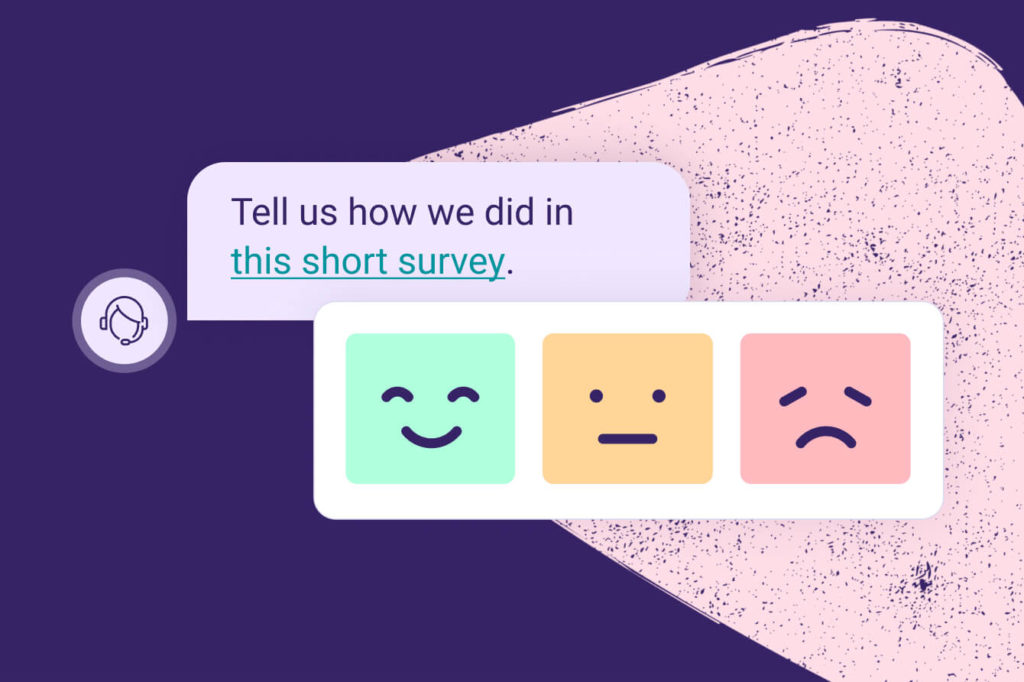In 2021, Statista reported that 10% of customers in the U.S. preferred communicating with customer service by text message. While this isn’t a majority, this number still represents a significant portion of a small business’s consumer base. And, offering those customers a way to give feedback by their preferred channel could improve brand perception and loyalty.
Business-to-consumer texting (or direct-to-consumer texting) works with an SMS messaging tool or software solution. SMS can help customers reach your customer support team to resolve issues and even order from your brand. Asynchronous communication not only puts the customer in control and solve issues on their time—it also lets your representatives multi-task and serve multiple customers at the same time.
However, there’s another feature that shouldn’t be left out when looking at SMS—text surveys.
Text surveys give your brand a chance to learn what consumers want while you’re making your next product or planning your next event. Learn about text surveys so that you can use them to gain customer insights and form stronger relationships between the customer and your brand.
What is a text survey?
A text survey is a very simple survey (usually one question) that recipients can answer with predesignated one- or two-word answers. From a CX standpoint, the question would most likely be something like “How would you rate our brand or service” or “How was your chat with XYZ?”. A simple, predetermined answer (“it was great” or “they were good”) gives you immediate and usable information that you could then use for follow-up texts. Was the service bad? Follow up with “What can you tell us about your experience that you were unhappy with?”
For the customer, these messages come through just like a text message from a friend or family member—creating an opportunity for instant feedback. That’s why these types of surveys are often used by online content creators and small businesses that want instant feedback from their followers and brand evangelists.
Benefits of text surveys
Text surveys can be a fast way for customer experience managers and product owners to collect customer feedback. However, understanding their pros and cons as well as ideal use cases will help you determine if they will be useful to your brand and, also, what questions you should ask for maximum impact.
Texts are opened more frequently than email.
According to Sinch, the average open time for a text message is 35x faster than email open times. That’s likely one reason many brands use text surveys to obtain instant feedback from customers.
But text surveys can be more complicated for some customers. Customers that are more likely to fill out a survey on their computer may find a two-way text survey to be cumbersome—texting a satisfaction rating or thoughts on an interaction may be more difficult than typing on a computer.
Texts effective for receiving quick feedback.
When using text messages for customer communication, brevity is key. And the same is true for text surveys. These are great tools for experience or product managers that need quick feedback about the customer experience, want to know a customer’s opinion right away, or need feedback after (or during) an event.
Let’s say you had an issue with your internet service. After calling into the company, they troubleshoot your issue over the phone and resolve it in 10 minutes. A text survey is perfect for gathering quick and simple information: “Did the agent solve your problem today? Reply ‘yes’ or ‘no’ to answer.” This can give a brand quick details on whether the customer needs more help and if the agent was effective.
Tip: Use a real-time feedback solution like Survey Dynamix to send personalized text surveys immediately after a customer-agent interaction.
However, text surveys should not be used for overly complicated questions, like questions that require long-form responses. Because typing on a phone is more difficult than a tactile keyboard, long response questions are likely to go unanswered.
How to use text surveys in your business
There are a few best practice guidelines when sending an effective text survey to your customers – and not just from a marketing or acquisition standpoint. Every part of the customer journey requires engagement – after a sale, before a subscription renewal, when a customer has complained to the call center when a shipment is delayed, or even when a customer doesn’t like the design of your website – any time your business or brand creates a touchpoint with your customer could qualify for a text survey. And everything starts with choosing the right software:
- Choose a text survey software. Look for a text survey software that can handle a large database of numbers, can integrate with your CMS (for customer service), and has the ability to sort survey responses, so you don’t have to change programs down the road.
- Obtain customer numbers and permission to text them. Build your database of customers and make sure you have permission to contact them so that you don’t get blocked and reported as spam.
- Build a relationship by offering things like discounts and first looks. Give before asking by offering discounts as thanks for signing up or a first look at a sale as thanks for being a connected customer.
- Determine what question you want to be answered. Choose the most important question because, unlike other survey methods, most SMS software can only handle one question within a set time period.
- Phrase the question clearly, so you get clear answers. Create a short but clear question and provide easy one- or two-word responses that recipients can easily text back.
- Send out the question to your text line. Use your text survey software to schedule, send, and track your text survey, as well as any additional comments or questions consumers may have.
How you send the survey specifically will depend on the software solution you’ve chosen. But the key to getting good feedback is to first create a relationship between you and the consumer, then ask clear and easy-to-respond-to questions.
Leverage your quick feedback.
One of the best parts of text surveys is the rapid response—both from the customer and directly to the agent or brand.
So make sure you utilize it!
If the results of your text survey goes to a data warehouse or CX aggregator that takes weeks to get back to you, you’re missing out on vital feedback that may need immediate responses. You could be missing out on glaring (or even simple) problems that are affecting many different customers, when you could have been using that feedback to enhance operations, messaging, programs, etc.
Make sure the tech you use leverages real-time technology to deliver feedback instantly via Slack or Teams, so your agents and managers can make swift (and informed) decisions to improve the customer experience. Then, actually use it! Spread wins to other teams to show bright spots in the customer experience. Or let the digital product managers know so they can enhance self serve offerings.
Summing up
Text surveys are a great way to learn about customer preferences. But, more than that, text lines are a great way to help answer customer questions, solve customer issues, and build relationships with brands. Mindful offers a messaging solution for brands that incorporate things like callback scheduling, delivery notifications, and analytics, so you can see how your efforts are paying off.





